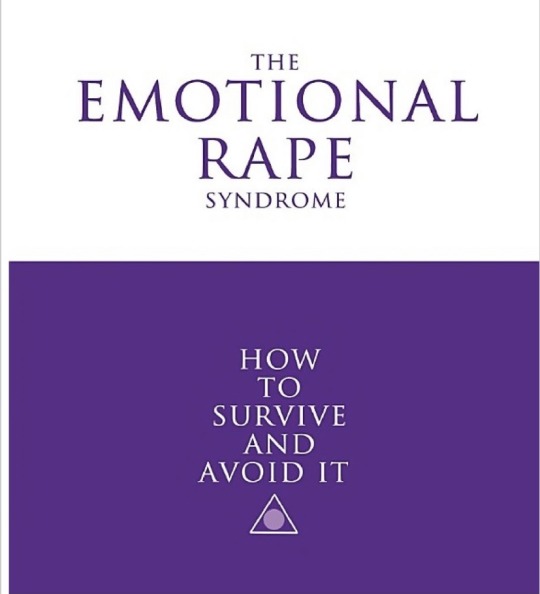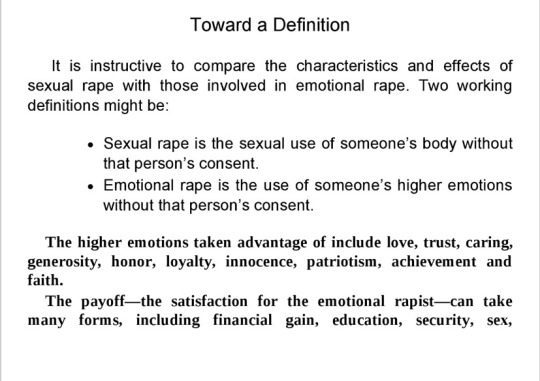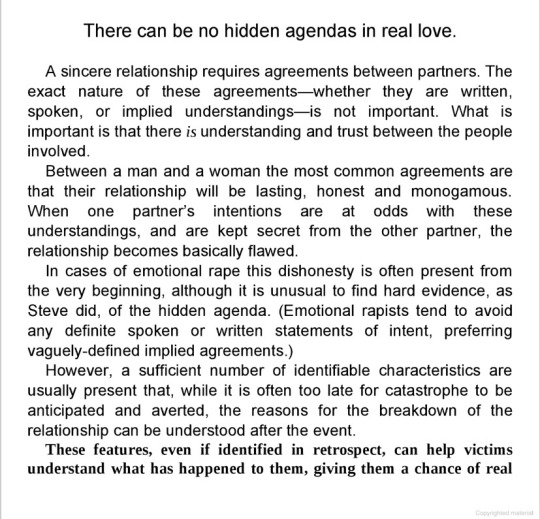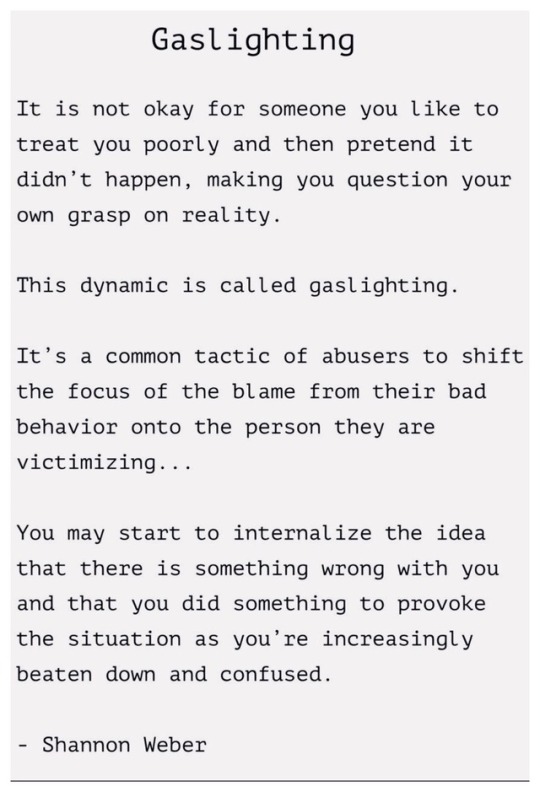Text
On the unique traumas of betrayal, and the failure of words to express them to others
https://youtu.be/_XJOYmezYwo
youtube
9 notes
·
View notes
Photo

Narcissists often recruit people called ‘apaths’ to help with their games — here’s why they’re dangerous
Narcissists sometimes recruit people to help them tear down their victim’s self esteem.
These people are called “apaths” and they are completely indifferent to the victim’s suffering.
Sometimes they genuinely don’t care, and other times they go along with the abuse because they don’t want to be the target themselves.
It just shows that you can’t trust someone else’s social circle to help you work out what’s really going on.
Defining someone’s personality is complicated. There are so many nuances in the ways people behave, and why they behave the way they do, that it isn’t always appropriate to give someone a specific label — even mental health professionals and psychologists can struggle.
In a very broad sense, empathy can be a defining quality for personality type. On one end of the scale you have empaths, who are highly sensitive and very in tune to other people’s emotions. On the other end, you have people who are devoid of empathy, such as sociopaths and narcissists. To further complicate things, there are people who are capable of feelings, but just don’t care enough to use them. These people are called “apaths.”
People with Dark Tetrad personality traits — sadism, Machiavellianism, psychopathy, and narcissism — play games with their partners to break down their self esteem. To succeed, they sometimes recruit helpers to help control and manipulate their partners. Apaths fit this role very well.
Shannon Thomas, author of “Healing from Hidden Abuse: A Journey Through the Stages of Recovery from Psychological Abuse,” told Business Insider an apath is someone who is apathetic to the harm in their social circle, particularly if someone is being manipulative, hurtful, or abusive. Their role, she said, is critical to the narcissist’s game.
“An apath is the wing-person to a narcissist and plays a key role in normalising the toxic individual and their harmful behaviors towards others,” she said. “A narcissist must have apaths in their life to keep the facade of social normalcy going. Apaths create the illusion that a narcissist has friends, is well-liked and can get along with everyone, except the target of abuse.”
Rather than standing up for the victim, or giving them support in the fact they are being mistreated, the apath will instead be completely indifferent to their suffering. When challenged, they come up with excuses and say things like “it’s not my battle,” or “well, they don’t treat me that way.”
By minding their own business, they are effectively being a pawn on the narcissist’s gameboard, making the victim believe they must be going crazy. In some online forums, apaths are known as “flying monkeys,” like the Wicked Witch’s helpers in “The Wizard of Oz.” They do all the narcissist’s dirty work behind the scenes while the narcissist can sit back and watch.
“Many apaths are also hidden abusers themselves and they will cluster together in family and friend groups to keep each other’s secrets,” Thomas said. “Another type of apath believes it is better to join the abuser in their games than ever run the risk of becoming a future target of the narcissist.”
In other words, apaths recruit an avoidance strategy and a “rather you than me” mindset to stay in the narcissist’s good books. This makes them particularly dangerous, because there’s no way to tell where their limits are. Studies have shown how people can blindly follow orders and become agents in a terrible, destructive processes as as result.
If you feel something is wrong with how you’re being treated, trust your gut. You can’t always depend on someone’s social circle to stand up for you, as it could be full of apaths. Instead, familiarise yourself with the red flags someone is bad news, and look out for yourself.
source
41 notes
·
View notes
Photo
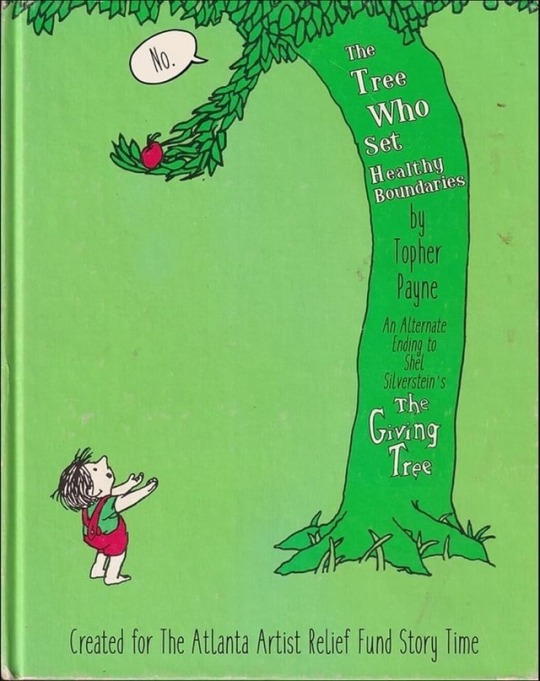
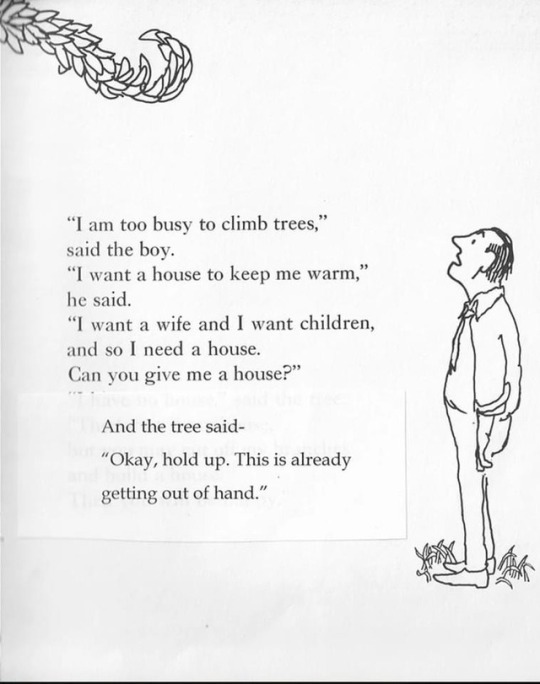

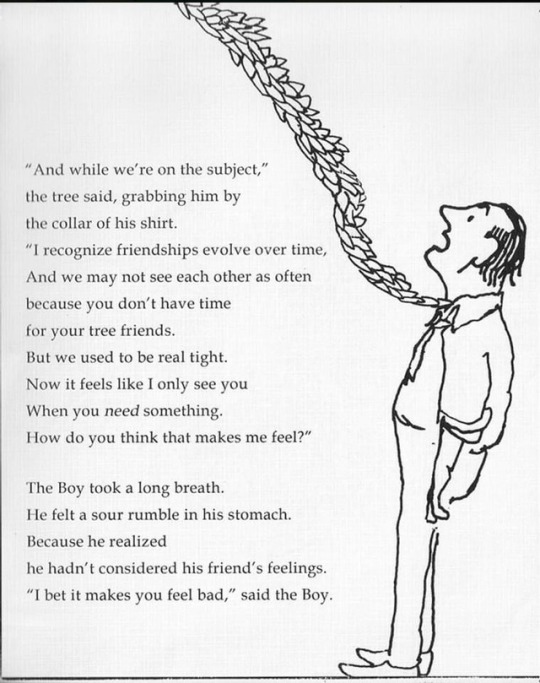






Sometimes classics can be improved upon.
The Tree Who Set Healthy Boundaries : an alternate ending for Shel Silverstein’s The Giving Tree by Topher Payne 💯🌳❤️
https://www.topherpayne.com/giving-tree?
166K notes
·
View notes
Photo
(Just a note that this occasionally contains grammatical mistakes that reverse the intended meaning of a sentence, e.g. accidental omitting of a ‘not’. The intended meaning should be recoverable from context.)
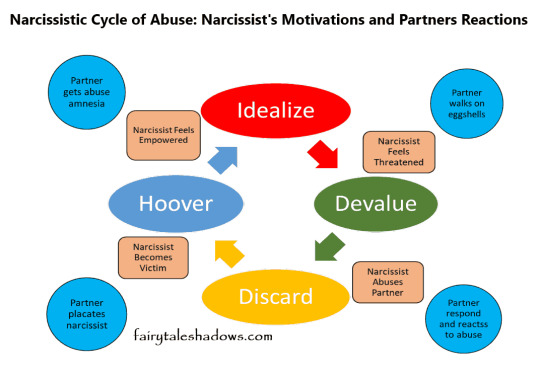
Abusive Devaluation And The Sadness Of Feeling Small: Common Methods That Make You Feel ‘Less Than.’
How do abusers devalue? This is primarily done by an abusive individual by placing priority over you, using anything and everything comparatively or as excuse.
When done repeatedly, it can become a clear pattern of devaluation, which comes after the abuser has idealized the victim to gain their attention and affection back, and it is done prior to the discard in which the abuser will ‘abandon’ or ‘disown’ the victim in some way.
Devaluation is also a big part of verbal abuse, but is also an insidious form of emotional and psychological abuse being inflicted upon the victim. Over time, devaluation can lead to low-self esteem and an increasing decline in mental health and overall well-being.
Here are some common ways that abusers will use to devalue their victims, including some specific examples of how this might be demonstrated through words or behaviors.
Other People Are Always Being Put First, Being Placed Ahead Of You:
They will ditch you, like for a trip with friends, only to say how ‘boring’ it was afterwards.
This tactic very well may be the ‘double-whammy’ that abusers so often crave as a weapon to inflict the most harm on their victims. They will show you how little you mean to them first by placing other people over you in their lives, sometimes this even means cancelling plans already made with you to hang out with others instead.
Any arguments or objections you may have will be discredited by the abuser as “being controlling” or trying to keep them from enjoying their personal freedoms in some way. They’ll make you out to be attacking them if you find fault or wrong in how they’re mistreating you through blatant disrespect.
Then, to top it all off, after they’ve had their excursion or outing, they’ll just come back to tell you how awful it was, how boring it was, how they didn’t really enjoy it at all. By doing so, they’ve essentially told you, ‘not only do I value my time spent with others over the time I spend with you, I’d rather even have a bad or boring time than dedicate my time by spending it with you.’
They’ll leave you right in the middle of something important, or abandon you for seemingly trivial matters…even for strangers:
Sometimes abusers will cause dramatic exit strategy scenes, whereby they will rage and leave you after the fight. Other times, their exit strategies are not so obvious.
One way could be ‘playing the hero,’ where the person is responding to a perceived problem or emergency situation. Someone has a flat tire and needs their help…in the middle of your date night dinner. You finally got to sit down to have a video chat with them after they got off work, then oops, someone needs a jump, their car won’t start. Perhaps they left something at their office, and they need to run back and get it…right at the time you’d already made plans to hang out.
The Abuser Is Always Too Busy…Even Too Busy To Care:
Just generally speaking, if an abusive person has made themselves readily and openly available, be prepared for dealing with a whole lot of ignoring or one-sided conversations. Have you ever felt like you’re mostly just talking to yourself?
Do they leave you on read, or even ignore your messages periodically, without even denoting a reason or letting you know they are now busy and will get back to you later? Yes, these are all classic signs of disrespect and mistreatment.
Many make the mistake of writing this type of behavior off as negligence or lack of responsibility, and while that can sometimes be possible, if it is being seen alongside other abusive behaviors, then it’s not just a simple communication issue or time management problem.
Work can’t be missed to spend time with you, even for special occasions, but okay for other reasons:
Now, they don’t mind to take off work for two week long international vacations, or to take an extended holiday across the country to go snowboarding…but if it comes down to taking off work to spend time with you, then it’s simply ‘unreasonable.’ They might even call you demanding, or that you’re asking for too much of them — even if this is something you hardly if ever ask of them.
Besides, it might even be the case you shouldn’t be having to ask at all…because people who want to spend time with you will make active efforts to dedicate their time into the relationship.
They are always chronically and severely late or are simply a no-show. You feel you spend your life waiting around on them:
Abusers do not value the time of other people. In fact, they actually quite enjoy the attention they are receiving when the party waiting around on them is trying to make contact with them while they are out being ‘busy’ and ‘doing something (or someone) else.’
If they care and you are a priority to them, it should show and reflect in their behavior and treatment of you. If what they are saying and how they are acting isn’t adding up, you could be experiencing this type of abuse.
You’re Pouring Your Heart Out And There’s No Reciprocity:
Dismissal of thoughts, feelings, or opinions as you being ‘overreactive.’
Abusers will use your reaction to how they are mistreating you to project their own behavior onto you, usually pairing this tactic with gaslighting, to make you feel as though you are the one out of your mind.
They’ve convinced you into believing you are the source of the problem, and may even end up apologizing for ‘being too harsh,’ for ‘not being more understanding,’ or for being ‘too sensitive,’ or the like.
Sadly over time, this feeds into the cognitive dissonance that victims of abuse often feel, whereby their beliefs and actions are not matching up with their real life experiences of themselves, the other person, and the interactions taking place between them.
If you feel you are never being listened to, that problems are never being resolved, that there are circular conversations, and that your partner is not reciprocating with the same level of openness, intimacy, and honesty as you — this could be a clear sign that there is dysfunction in the relationship and that abuse is likely happening.
They evoke emotion then abandon you after, with no comfort or reciprocating of feelings:
This will leave you often feeling invalidated in your experiences, and it will make you feel that the other person genuinely does not care and is disinterested in the things that matter most to you.
By blowing off your biggest and most sincere feelings, they are letting you know clearly that they find them insignificant in comparison to something else, are uninterested, regard your experience as trivial, or do not feel what you have to say is worth their time and effort.
This do not even have to be negative feelings, they might just have gotten you to open up, to reveal private details about yourself, whereby a normal person may expect to be comforted or talked to in a loving manner afterwards. Either way, they’ll make you feel unimportant by expressing their disregard for the essential parts of you that make you who you are.
They Show You That Even Your Actual Life Is Not Even Worth Time, Effort, Concern, Or Consideration:
If they value anything over your safety or life, making excuses to ignore clear indications of physical illness or mental well-being, then they absolutely do not care about you and are abusive. Period.
This one is just the absolute worst scenario imaginable, and perhaps the most indicative that you are dealing with a cruel individual incapable of empathy or compassion for other human beings. To see someone else in danger, to know they are in incredible pain or distress, and to not only answer that call for help but to seek to remedy or offer a helping hand to that person is beyond heartless.
This is like watching another person literally dying while standing over them, taking no action, just watching — or worse, saying something awful like, ‘Well, I guess everybody’s got to die sometime.’ These type of sadistic abusers are the ones who often encourage their partners to commit suicide, or will not often help when they are in need of emergency medical care, or will disregard physical ailments as genuine cause for concern.
There is never a valid excuse to intentionally put another person in harm’s way, nor to intentionally refrain from acting if there is legitimate cause for concern regarding someone’s health.
‘Forgetting’ important comments or milestones:
In many cases, abusers do not ever actually forget what they’ve said or the harm they’ve inflicted on their victims. This is only a part of their larger campaign to gaslight you into think you’re crazy, to minimize your perceptive pain, or to in some way create an excuse for the situation which had been distressing to you.
What is hoped to be accomplished by the abuser doing this? They want to show you that the thing which are most painful to you are not even important enough to them to even remember, let alone, for you to feel.
They make you feel so insignificant by doing this that is just simply near impossible to ignore this clear sign of emotional abuse. Being oblivious to the pain of others is not something that is to be expected from healthy individuals and relationships.
Minimizing harm done to you by using rational mitigating factors as excuse:
If a person is making excuses, using drugs or alcohol, uncontrollable anger, or their own pain as reasons for mistreating you or disregarding your own pain and feelings, then this is a clear sign of minimization.
This is a tactic often used by abusers to emotionally manipulate their victims, creating low-self worth and increasingly the likelihood they will continue to withstand being disrespected.
There’s not ever really much of a valid excuse to harm someone, and it is not a sign of respect or empathy to ignore someone’s pain by placing emphasis back on your own. People who cannot own their mistakes or make apologies for their own bad behavior are usually the same personalities who end up abusing others.
There’s Sadly More Where That Came From.
These are certainly not all the ways in which abusive people devalue others who they have targeted. If you feel you are being abused, then you probably are.
Please realize that abuse is not okay, and that no one deserve to be abused.
It is absolutely NOT okay if someone expresses satisfaction or dismissal with your dying, dismisses legitimate concerns for health or physical safety, or is encouraging your suicidal thoughts.
If you are feeling suicidal now or having thoughts about ending your life, please call the National Suicide Prevention Lifeline at 1–800–273–8255 or click here to chat now.
source
44 notes
·
View notes
Text
There’s a fine line between devotion and delusion. Love can break more than your heart; it can shatter your mind.
—O-Bengh (Marvel’s What If… ?, episode 4)
7 notes
·
View notes
Text
Alternative Responses to Mistreatment
(Antagonistic vs Contra-antagonistic Processing of Antagonism)
What follows are two different chains of thought, which reflect alternative responses to significant mistreatment.
1
I experienced the hurt/damage of that treatment;
furthermore, I now have the sense that people in general are at least somewhat likely to mistreat others;
therefore, I must similarly act without regard for others (to prevent or pre-empt my own future mistreatment, or to compensate for my own suffering, or because others are ultimately bad and thus deserve it, or because one must look out for one’s self exclusively because one cannot trust others, or to ensure that I’m the winner/victimiser because otherwise I might be the loser/victim, or because everyone’s capable of doing it and it seems the only sure way to get ahead in life, or ...)
2
I experienced how hurtful/damaging such treatment can be;
furthermore, I want no one to suffer in such a way;
therefore, I must be careful to never treat others similarly.
______________
Probably, responding in one way rather than the other is heavily influenced by one’s existing personality tendencies, with response 1 indicating initially lower agreeableness (higher trait antagonism) and response 2 indicating initially higher agreeableness (lower trait antagonism).
An instance of mistreating others or acting without regard for others is itself an instance of antagonism, such that a stable disposition towards doing such things is a strong predictor of low agreeableness, or high trait antagonism. Conversely, a stable disposition towards acting with regard for others (e.g. out of respect, compassion, conscience, a sense of fairness, or even naivety) is a strong predictor of high agreeableness, or low trait antagonism.
Accordingly, response 1 might be described as the disagreeable or trait antagonistic response to significant antagonism, while response 2 might be described as the agreeable or trait contra-antagonistic response to significant antagonism.
12 notes
·
View notes
Text
Recognizing emotionally mature people
Taken from Adult Children of Emotionally Immature Parents by Lindsay C. Gibson, Psy.D. A summary of the tips the book hands you on how to recognize emotionally healthy people.
They’re realistic and reliable
They work with reality rather than fighting it. They see problems and try to fix them, instead of overreacting with a fixation on how things should be.
They can feel and think at the same time. The ability to think even when upset makes an emotionally mature person someone you can reason with. They don’t lose their ability to see another perspective just because they aren’t getting what they want.
Their consistency makes them reliable. Because they have an integrated sense of self, they usually won’t surprise you with unexpected inconsistencies.
They don’t take everything personally. They can laugh at themselves and their foibles. They’re realistic enough to not feel unloved just because you made a mistake.
They’re respectful and reciprocal
They respect your boundaries. They’re looking for connection and closeness, not intrusion, control or enmeshment. They respect your individuality and that others have the final say on what their motivations are. They may tell you how they feel about what you did, but they don’t pretend to know you better than you know yourself.
They give back. They don’t like taking advantage of people, nor do they like the feeling of being used.
They are flexible and compromise well. Because collaborative, mature people don’t have an agenda to win at all costs, you won’t feel like you’re being taken advantage of. Compromise doesn’t mean mutual sacrifice; it means a mutual balancing of desires. They care about how you feel and don’t want to leave you feeling unsatisfied.
They’re even-tempered. They don’t sulk or pout for long periods of time or make you walk on eggshells. When angered, they will usually tell you what’s wrong and ask you to do things differently. They’re willing to take the initiative to bring conflict to a close.
They are willing to be influenced. They don’t feel threatened when other people see things differently, nor are they afraid of seeming weak if they don’t know something. They may not agree, but they’ll try to understand your point of view.
They’re truthful. They understand why you’re upset if they lie or give you a false impression.
They apologize and make amends. They want to be responsible for their own behavior and are willing to apologize when needed.
They’re responsive
Their empathy makes you feel safe. Along with self-awareness, empathy is the soul of emotional intelligence.
They make you feel seen and understood. Their behavior reflects their desire to really get to know you, rather than looking for you to mirror them. They aren’t afraid of your emotions and don’t tell you that you should be feeling some other way.
They like to comfort and be comforted. They are sympathetic and know how crucial friendly support can be.
They reflect on their actions and try to change. They clearly understand how people affect each other emotionally. They take you seriously if you tell them about a behavior of theirs that makes you uncomfortable. They’ll remain aware of the issue and demonstrate follow-through in their attempts to change.
They can laugh and be playful. Laughter is a form of egalitarian play between people and reflects an ability to relinquish control and follow someone else’s lead.
They’re enjoyable to be around. They aren’t always happy, but for the most part they seem able to generate their own good feelings and enjoy life.
– © Adult Children of Emotionally Immature Parents, Lindsay C. Gibson, Psy.D.
73K notes
·
View notes
Text

#dissociation#derealization#depersonalization#identity#identity disturbance#disconnection#confusion#emotional flashbacks#ptsd#bpd#trauma#emotional pain#distress#coping#dissociative amnesia#memory disturbance#thought disturbance#emotional dysregulation
181 notes
·
View notes
Text
I’m sure there’s at least one person [...] who needs closure about something, and you’re the only person who can give it to ‘em.
—Sam Wilson (The Falcon and The Winter Soldier)
4 notes
·
View notes
Text
Gaslighting
to gaslight (verb)
while knowingly interacting with another person, to behave unjustifiedly, for purposes not plainly apparent to that person, in ways that might foreseeably increase the extent to which that person doubts her sanity or her independent ability to reason or to understand evident reality.
4 notes
·
View notes
Text
Adult Attachment Styles and Intimacy
(This post is largely an edited copy-paste of the Wikipedia entry “Attachment in Adults”.)
The Adult Attachment Styles
Four main styles of attachment have been identified in adults:
Secure
Anxious-Preoccupied
Dismissive-Avoidant
Fearful-Avoidant
The Secure Attachment Style
Secure patterns of attachment behaviour are associated with a disposition to have a positive view of both self and others (i.e. a positive view of both one’s self and one’s potential figures of attachment). [For this reason, in relation to personality traits, the secure attachment style has an association both with levels of Agreeableness that are moderate or slightly higher than moderate, and with levels of Neuroticism that are not overly high.]
Securely attached adults tend to agree with the following statements:
It is relatively easy for me to become emotionally close to others.
I am comfortable depending on others and having others depend on me.
I don't worry about being alone or others not accepting me.
This style of attachment usually results from a history of warm and responsive interactions with attachment figures. Securely attached adults tend to have positive views of themselves, their attachments, and their relationships. They often report greater satisfaction and adjustment in their relationships than adults with other attachment styles. Securely attached adults feel comfortable both with intimacy and with independence.
During development, a secure attachment style and adaptive functioning are facilitated by caregivers who are emotionally available and appropriately responsive to their children’s attachment behaviours, as well as capable of regulating their own positive and negative emotions.
The Insecure Attachment Styles
In general, studies have shown that individuals with an insecure attachment style may be more vulnerable to mental health problems such as depression and anxiety disorders, in addition to having more difficulty with developing healthy attachments in adulthood.
Anxious-Preoccupied
Anxious-preoccupied patterns of attachment behaviour are associated with the disposition to have a negative view of self and a positive view of others (i.e. a positive view of potential figures of attachment). [For this reason, in relation to personality traits, the anxious-preoccupied attachment style has an association both with high levels of Neuroticism and with moderate-high levels of Agreeableness.]
Adults with the anxious-preoccupied attachment style tend to agree with the following statements:
I want to be completely emotionally intimate with others, but I often find that others are reluctant to get as close as I would like.
I am uncomfortable being without close relationships, but I sometimes worry that others don't value me as much as I value them.
Adults with this style of attachment tend to seek high levels of intimacy, approval, and responsiveness from their attachment figure. They sometimes value intimacy to such an extent that they become overly dependent on the attachment figure. Compared to adults who are securely attached, adults who have an anxious-preoccupied attachment style tend to have less positive views about themselves. They may feel a sense of anxiousness that only recedes when in contact with the attachment figure. They often doubt their worth as an individual and blame themselves for the attachment figure's lack of responsiveness.
Adults who have an anxious-preoccupied style of attachment may exhibit high levels of emotional expressiveness, emotional dysregulation, worry, and impulsiveness in their relationships.
Dismissive-Avoidant
Dismissive-avoidant patterns of attachment behaviour are associated with the disposition to have a positive view of self and a negative view of others (i.e. a negative view of potential figures of attachment). [For this reason, in relation to personality traits, the dismissive-avoidant attachment style has an association with low levels of Agreeableness and levels of Neuroticism that are not overly high (excluding the facet of anger/irritability).]
Adults with this dismissive style of avoidant attachment tend to agree with the following statements:
I am comfortable without close emotional relationships.
It is important to me to feel independent and self-sufficient.
I prefer not to depend on others or have others depend on me.
Adults with this attachment style desire a high level of independence. The desire for independence often appears as an attempt to avoid attachment altogether. They view themselves as self-sufficient and invulnerable to feelings associated with being closely attached to others. They often deny needing close relationships. Some may even view close relationships as relatively unimportant. They seek less intimacy with attachment figures, who they often view less positively than they view themselves. Investigators commonly note the defensive character of this attachment style. Adults with a dismissive-avoidant attachment style tend to suppress and hide their feelings, and they tend to deal with rejection by distancing themselves from the sources of rejection (e.g. their attachments or relationships).
The dismissive style of avoidant attachment is by far the most common attachment style among those with Narcissistic Personality Disorder.
Fearful-Avoidant
Fearful-avoidant patterns of attachment behaviour are associated with the disposition to be unstable or fluctuating in one’s view of self and others. [In relation to personality traits, the fearful-avoidant attachment style has an association with both high levels of Neuroticism and low levels of Agreeableness.]
Adults with significant losses or other trauma, such as sexual abuse in childhood or adolescence, appear to be more likely to develop this fearful style of avoidant attachment. Adults with this style of attachment tend to agree with the following statements:
I am somewhat uncomfortable getting close to others.
I want emotionally close relationships, but I find it difficult to completely trust others, or to depend on them.
I sometimes worry that I will be hurt if I allow myself to become too close to other people.
They tend to feel uncomfortable with emotional closeness and with attempts by others to establish such intimacy. This is despite the fact that, when they are not currently in a context of emotional closeness, they tend to pursue relationships that are characterised by such closeness (e.g. romantic relationships). The mixed feelings of the fearful-avoidant style tend to be combined with (sometimes unconscious) negative views about one’s self and one’s attachment figures, or with views of attachment figures that fluctuate between positive and negative. Those who have a fearful-avoidant attachment style commonly view themselves as unworthy of responsiveness from their attachment figures, but also tend not to trust the intentions of their attachment figures. Similar to the dismissive style of avoidant attachment, adults with the fearful style tend to seek less intimacy from attachment figures (at least in the context of an existing relationship) and frequently suppress and/or deny their feelings. Because of this, they can be uncomfortable expressing genuine affection.
While it can seem as though many individuals with Borderline Personality Disorder have the anxious-preoccupied attachment style, the fearful style of avoidant attachment is by far the most common attachment style among individuals with this personality disorder.
Intimacy and Styles of Attachment
Attachment theory has always recognised the importance of intimacy. Bowlby writes:
“Attachment theory regards the propensity to make intimate emotional bonds to particular individuals as a basic component of human nature, already present in germinal form in the neonate and continuing through adult life into old age.” (Bowlby, 1988, pp. 120–121)
The desire for intimacy has biological roots and, in the great majority of people, persists from birth until death. The desire for intimacy also has important implications for attachment. Relationships that frequently satisfy the desire for intimacy tend to cause more secure attachments. Relationships that rarely satisfy the desire for intimacy tend to cause less secure attachments.
Collins and Feeney have examined the relationship between attachment and intimacy in detail. In the context of a relationship, or attachment, they define intimacy as resulting from a special set of alternating interactions in which:
(A) One person discloses something important about herself to the other person (her attachment figure).
(B) Her attachment figure responds to her self-disclosure in a way that makes her feel validated, understood, and cared for.
Such interactions, which undergird intimacy, usually involve verbal self-disclosure, but can also involve non-verbal forms of self-expression such as touching, hugging, kissing, and sexual behaviour.
From this perspective, intimacy requires the following:
Willingness to disclose one's true thoughts, feelings, wishes, and fears
Willingness to rely on an attachment figure for care and emotional support
Willingness to engage in physical intimacy in the case of romantic or potential romantic partners
Accordingly, Collins and Feeney reviewed a number of studies that looked at how each attachment style relates to the willingness to self-disclose, the willingness to rely on partners, and the willingness to engage in physical intimacy. Perhaps unsurprisingly, they concluded that the secure attachment style is generally related to more self-disclosure, more reliance on partners, and more physical intimacy than the other attachment styles. However, they also noted that the amount of intimacy in a relationship can vary due to personality variables and situational circumstances, and suggested that each attachment style might function, in its particular characteristic way, to adapt an individual to the context of intimacy in which she happens to live.
Mashek and Sherman reported some findings on relationships between attachment styles and desiring less emotional closeness with partners. On one hand, these findings are predictable: People who have the fearful-avoidant and anxious-preoccupied attachment styles typically want greater emotional closeness with their partners (under threat of anxiety), and people who have the dismissive–avoidant attachment style typically want less emotional closeness with their partners. On the other hand, the relatively large numbers of people who admit to wanting less emotional closeness with their partners (rising to 57%, in some studies) far outnumbers the people who have the dismissive-avoidant attachment style. This suggests that people who have some other attachment style (secure, anxious–preoccupied, or fearful-avoidant) sometimes seek less emotional closeness with their partners, possibly as a result of situational factors. In short, individual differences in the desire for less emotional closeness with partners are not solely accounted for by individual differences in attachment style.
***
General Remarks about Adult Attachment Theory
Mary Ainsworth and John Bowlby founded modern attachment theory on studies of children and their caregivers. Obviously, relationships between adults differ in many ways from relationships between children and caregivers. And adult attachment theory does not presume that these two kinds of relationships are identical. Rather, it presumes that the core principles of attachment theory apply both to child-caregiver relationships and to adult relationships.
Investigators’ descriptions of the core principles of adult attachment theory vary quite a bit, at least on a superficial level. For example, Fraley and Shaver describe the “central propositions" of attachment in adults as follows:
The emotional and behavioural dynamics of infant-caregiver relationships and adult relationships are governed by the same biological system.
The kinds of individual differences observed in infant-caregiver relationships are similar to the ones observed in various close adult relationships.
Individual differences in adult attachment behaviour are reflections of the expectations and beliefs people have formed about themselves and their close relationships on the basis of their attachment histories; these “working models” are relatively stable and, as such, may be reflections of early caregiving experiences.
Romantic love, as commonly conceived, involves the interplay of attachment, caregiving, and sex.
Compare this with the five “core propositions” of attachment theory as listed by Rholes and Simpson:
Although the basic impetus for the formation of attachment relationships is provided by biological factors, the bonds that children form with their caregivers are shaped by interpersonal experience.
Experiences in earlier relationships create internal working models and attachment styles that systematically affect attachment relationships.
The attachment orientations of adult caregivers influence the attachment bond their children have with them.
Working models and attachment orientations are relatively stable over time, but they are not impervious to change.
Some forms of psychological maladjustment and clinical disorders are attributable, in part, to the effects of insecure working models and attachment styles.
The above lists clearly reflect the differing theoretical interests of the investigators who created them. However, a closer look reveals a number of shared themes. In particular, they share the following sentiments about adult attachment:
People are biologically driven to form attachments with others, but the process of forming attachments is influenced by learning experiences.
Individuals form different kinds of attachments depending on the expectations and beliefs they have about their relationships. These expectations and beliefs constitute internal “working models” that function to guide those individuals’ relationship behaviours.
In adults, these internal “working models” are relatively stable across the lifespan, even though they can be influenced by experience.
Differences among individuals in their attachment styles contribute (both positively and negatively) to individual differences in both mental health and the quality of individuals’ relationships with others.
Regarding the core principles of adult attachment theory, these shared themes are certainly not exhaustive. The key insight of the field, however, is simply that the same basic principles of attachment apply to close relationships throughout the lifespan.
Accordingly, the secure attachment style in adults corresponds to the secure attachment style in children. The anxious–preoccupied attachment style in adults corresponds to the anxious-ambivalent attachment style in children. However, the dismissive-avoidant attachment style and the fearful-avoidant attachment style, which are distinct in adults, both correspond to the avoidant attachment style in children.
#attachment#adult attachment#secure attachment#insecure attachment#anxious attachment#anxious-preoccupied attachment#avoidant attachment#fearful-avoidant attachment#dismissive-avoidant attachment#intimacy#emotional closeness#relationships#psychology#personality#personality disorders#narcissistic personality disorder#borderline personality disorder
148 notes
·
View notes
Text
Different Concepts of Dissociation
Dissociation as unusual nonconsciousness, nonintegration, or inconsistency of mental processes
NONCONSCIOUSNESS: unusually absent conscious awareness of either impinging stimuli (as in hypnotically suggested negative hallucination) or ongoing behaviors (as in sleepwalking)
NONINTEGRATION: nonintegration of mental processes that should be integrated in the person’s consciousness, memory (as in dissociative amnesia, dissociative fugue), or identity (as is chronic in Dissociative Identity Disorder)
INCONSISTENCY: inconsistency of ongoing behavior or perception with a person’s sincere introspective verbal report; from the third person perspective, potentially indistinguishable in some cases from being repression (of memories, emotions, thoughts, impulses) or manifestation of a repressive coping style
Dissociation as altered consciousness: experiential disconnection/disengagement from the self or the environment
ABSORPTION: unusual absorption in fantasy or an imaginal scenario (which typically excludes from attention present bodily sensations or perceived features of the environment)
DEPERSONALISATION: experience of bodily sensations or perceptions of the environment as not belonging to one’s self, or experiencing the self as being removed or distant from the body
DEREALISATION: experience of one’s present environment or bodily sensations as being distant, dreamlike, or unreal in some way
#dissociation#consciousness#conscious awareness#integration#nonintegration#depersonalisation#derealisation#repression#defence mechanism#altered consciousness#amnesia#fugue#dissociative amnesia#dissociative fugue#dissociative identity disorder#DID#memory#identity#experience#trauma#freeze response#flight response#inescapable#mental escape#borderline personality disorder#BPD#happy place#shut down#shut off emotions#numb
47 notes
·
View notes
Text

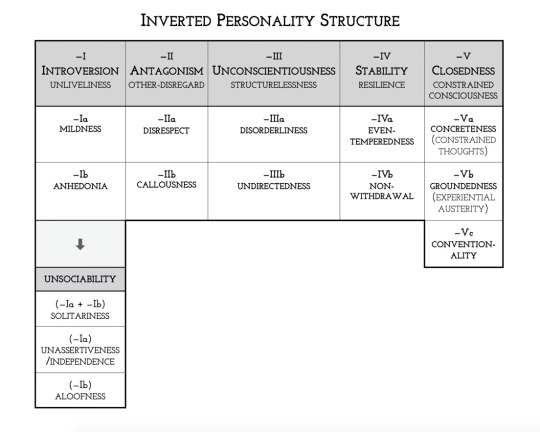
Dimensional Structure of Observed Personality Variation
1 note
·
View note
Text
“When you teach your daughter, explicitly or by passive rejection, that she must ignore her outrage, that she must be kind and accepting to the point of not defending herself or other people, that she must not rock the boat for any reason, you are not strengthening her prosocial sense; you are damaging it—and the first person she will stop protecting is herself.”
— Martha Stout, The Sociopath Next Door (via the-courage-to-heal)
26K notes
·
View notes
